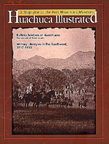 Huachuca
Illustrated, vol 1, 1993:
Huachuca
Illustrated, vol 1, 1993: Huachuca
Illustrated, vol 1, 1993:
Huachuca
Illustrated, vol 1, 1993:
chuca Illustrat
chuca Illustrat
U.S. Army Lifestyles at Huchuca in the
Teens:
Prohibition
chuca Illustrat

During prohibition at Huachuca (1918-33), the commanding officer, Colonel Winans, issued orders against drinking on the post. One of his junior officers observed that "The old man liked to take a drink now and then, but he didn't because he'd gave strict orders."
A soldier driver in civilian dress, but wearing issued shirt, tie and shoes. From the Markel Collection.
The officers were not above making their own beverages as one lieutenant attested. "...I made some home brew and put it down under the floor. There was a trap door and under there was some sort of cellar. I don't know what they used it for but it was nice and cold anyway." His men had to travel all the way to the Mexican line, at Lochiel, to obtain their alcohol.
Richmond recalled one party got up for the officers along the border.
We threw a party for the officers at Lochiel; for the officers of the 25th and 10th Cavalry, and I had ordered from Nogales five quarter barrels of beer to be delivered to me at Santa Cruz. I put them in the rear of my Studebaker, covered them up with eight sacks of potatoes, having arranged previously for the line rider to ride east along the line for some purpose which he did, and brought the five cases of beer into Lochiel. We had a lovely "beer bust" and, darn about this, I sent a pitcher of beer down to the line rider. The next day he rode past on his horse and he said that was certainly good near beer you sent me yesterday. Later standing at the gate at Nogales the guards there said that it has been rumored here that some of the officers up at Fort Huachuca are smuggling beer across the line down there. I said I hadn't heard anything about it. I think that report was false and it has stayed that way ever since.
One kind of bootleg booze was Mexican mescal that was smuggled across the line. It was powerful stuff. Richmond remembered:
There was one time we had an influx of Mexican burro trains coming across the border down through Hereford. They had a trail from the mine right straight up. The soldiers would get a hold of this damn stuff, it was brought up in tin cans and they would take a few drinks of it, and God, they would get right down on their hands and knees and root like a pig.(45)
Private James Clark remembered the men used to go across the line into Mexico to drink "Tequila" and bring back bottles.(46)
John D. McCaskey, the college-age son of the post commander in 1928-30, later related his own violation of the law of the land and of his father.
Dad was by no means a teetotaler, but those were prohibition times and since his oath as an officer involved upholding the constitution, he ran a dry post. That applied to his sons. We used to go down opposite sides of the Nogales fence, out of sight of customs, and forward pass a bottle to one another.
Before we got to the reservation, the bottle was buried in the desert for future reference.(47)
In 1983, archaeologist John P. Wilson was hired to examine an old trash dump at Fort Huachuca before it was lost to bulldozers building a new airfield runway. The dump, used between 1917 and 1928 by the 10th Cavalry Regiment, was primarily for glass containers and ceramic tableware. The bottles found had primarily contained beer, tequila, soft drinks, ketchups, sauces, skin cremes and toiletries. The archaeologist concluded that the beer bottles contained "near beer" with less than 1.4 percent alcohol, a legal drink on a military base during these times of Prohibition. Regarding the variety of skin ointments found, a doctor from the USA Health Services Command concluded: "Cavalry soldiers require skin protection. Skin irritation and damage are greatly accelerated in a dry climate with an intense solar radiation."(48)
Footnotes:
47. McCaskey papers in FHM files.
48. Wilson, John P., Fort Huachuca in the Prohibition Era, Fort Huachuca, 1984.